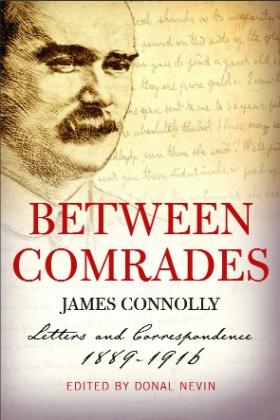Between comrades: James Connolly, letters and correspondence, 1889–1916
Published in 18th-19th Century Social Perspectives, 18th–19th - Century History, 20th Century Social Perspectives, 20th-century / Contemporary History, Issue 3 (May/Jun 2008), Reviews, Revolutionary Period 1912-23, Volume 16 Between comrades: James Connolly, letters and correspondence, 1889–1916
Between comrades: James Connolly, letters and correspondence, 1889–1916
Donal Nevin (ed.)
(Gill & Macmillan, €29.99)
ISBN 9780717142231
At last! After decades of calls to action, a beginning has been made. In this volume nearly all of James Connolly’s letters are collected. In addition, the first pages contain much correspondence unconnected with him save insofar as they concern his Irish Socialist Republican Party (ISRP). Though each of these is, in itself, a bore, in total they reveal very well the stresses involved in building a small socialist organisation, in some ways a bigger task in the 1890s than today.
Inevitably some of Connolly’s writings are banal, too. Nonetheless their totality gives a far clearer picture of the man than any of the biographies, or even the loyal memoir of his daughter Nora. He reveals his development from the hot-tempered organiser of the ISRP, throwing away his initiative in the struggle with that party’s opportunists, to the long-suffering organiser of the Irish Transport and General Workers’ Union (ITGWU), protesting against but not breaking from Larkin. A poignant passage (p. 231) reports how he could not keep his promise to his eldest daughter, Mona, to bring her to America; she would die in Dublin after his departure. We get some idea, too, of his contemporaries—Larkin, Carstairs Matheson, young William O’Brien and, through the appendix, his most formidable opponent, Daniel de Leon, and how their clash was enhanced by personal incompatibility.
What interests in Connolly’s career, however, is not his personality but his politics. Here, too, there are revelations. It is clear that in the ISRP split, and despite his tactical error in resigning, he was correct, as against those who saw the party paper as ‘a drag’ (p. 411). His change from allegiance to a sectarian party to belief in the industrial union as the motor of working-class power is made clear. The claim that he abandoned the aim of such power after August 1914 is challenged in his letter to O’Brien of 6 June 1910 (p. 424), where his position on Irish indepencence is asserted in the same terms as his statement at his court martial in 1916 (p. 547). It is clear, too, that, unlike some of his self-styled followers, he understood the difference between full Irish self-determination and the provincial self-government represented by Home Rule.
The letters reclaim Connolly’s friend Matheson, too. On page 141 he makes the connection, made clear since by history, that reformism leads to the abandonment of internationalism. He is far more scathing than Connolly concerning the ‘crypto-fisherman type . . . essentially and congenitally individualistic’ (p. 439). This latter attitude, with Connolly’s criticism of his ‘comparing the actual with the conceivable’ (p. 458), shows an ultra-leftism that would rebound to cause Matheson to enlist in the British Army and then, in 1919, to renounce socialism altogether, allowing John Maclean to surpass him as Scotland’s greatest Marxist.
Collecting this material was a tremendous achievement; the weakness is in the editing. The 74-page introduction is too long, essentially a précis of Nevin’s Connolly biography that adds little to the main texts. There are some strange omissions. The letter to Edward (Eamon) Lynch on 23 May 1911 (pp 460–1) is one of the most political pieces but it is incomplete, part of it being ‘missing from the National Library of Ireland file’. Actually, the full text is in the ITGWU’s Watchword of Labour of 30 October 1920. Larkin’s directive appointing Connolly as his full replacement does not appear. The actual texts of Connolly’s first dispute with de Leon on the basic issues of economics, religion and family are excluded, leaving the reader to get what can be got from tantalising hints mainly in Matheson’s correspondence.
The editing is weakest precisely in this book’s biographical notes. Robert Dorman did not lose his northern Irish senate seat because proportional representation (PR) was introduced but because its abolition reduced the numbers of MPs supporting him. James McCarron did not serve on the ITUC parliamentary committee until 1918; when the Larkinites got a majority on it from 1910, he refused to stand. William Walker did not end his political activity in ‘Northern Ireland’ after 1907 (p. 661); he ran later for Belfast Corporation as a ‘People’s Candidate’. There are other examples. Such errors can and should be corrected in the next edition. Meanwhile, despite them, it’s well worth reading.
D. R. O’Connor Lysaght is the author of The story of the Limerick Soviet (3rd edn, 2003).
















